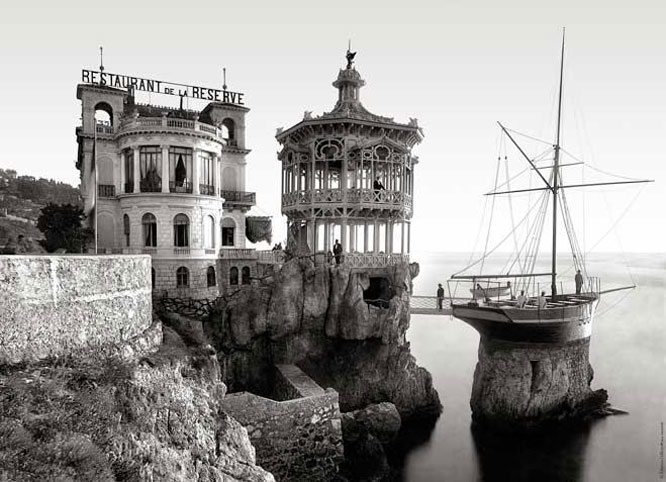
Restaurant de la Réserve, Nice, France, c. 1900 by Jean Gilletta
This is a photograph so magical I would be willing to wager you will never forget it. Antique pictures often have the power to evoke deep feelings of wonder and yearning. What would it be like, we speculate and dream, to be in such a place, to be part of that scene? This enchanting image from the Belle Epoque possesses that magnetism to an exceptional degree.
The structure unfolds across the picture, from dry land to water, like a poetically balanced equation. Multiply a charming but unremarkable building by an ornately fretted, fairytale pavilion and the product is a sailing boat becalmed in the air on a pedestal of rock: from the solidity of stone to windowless transparency to the cat’s cradle of the mast and rigging. To take a meal in the dining room would be to long to climb the steps to the nearby pavilion; to enter and ascend the pavilion would be to long to cross the gangway and occupy a seat on the boat. Can it be an accident that the few figures are so perfectly arranged to demonstrate the appeal of the restaurant’s vantage points, which culminate, at the boat’s prow, with a soulful view out to sea?
The photographer assumed a position directly opposite the man looking our way in the center of the picture. His name was Jean Gilletta (1856–1933, sometimes spelt Giletta) and, after learning his trade in a Paris studio, he became one of the South of France’s leading outdoor photographic reporters. The restaurant, documented around 1900, could be found on the coast road to the east of Nice’s port, and it was often shown from various angles on postcards of the era, which confirm that Gilletta found the best sightline. A picture he took in the early 1880s, before the wooden boat was levitated into place, reveals that the first pavilion to colonize the outcrop was a much plainer enclosed structure.
I say “could be found,” but there is still a restaurant on the spot. The pavilion is long gone, as is the boat, which was replaced by a three-tier diving platform until this was abandoned for being too dangerous. In 2014, plans were announced to develop the site with a bar and a terrace on the rocks. It isn’t surprising that the restaurant website shows off its historical heritage by featuring the photo, but there is something a little forlorn about the reminder. The edifice in Gilletta’s picture is so much more than somewhere to eat: metaphysically distant and mysterious to its core.
See all Exposure columns


Comments [1]
03.05.15
01:30